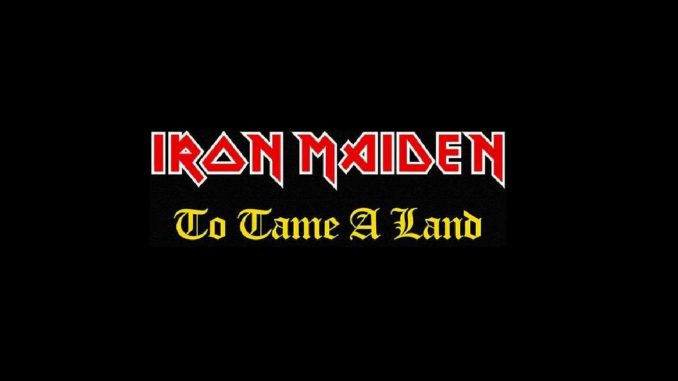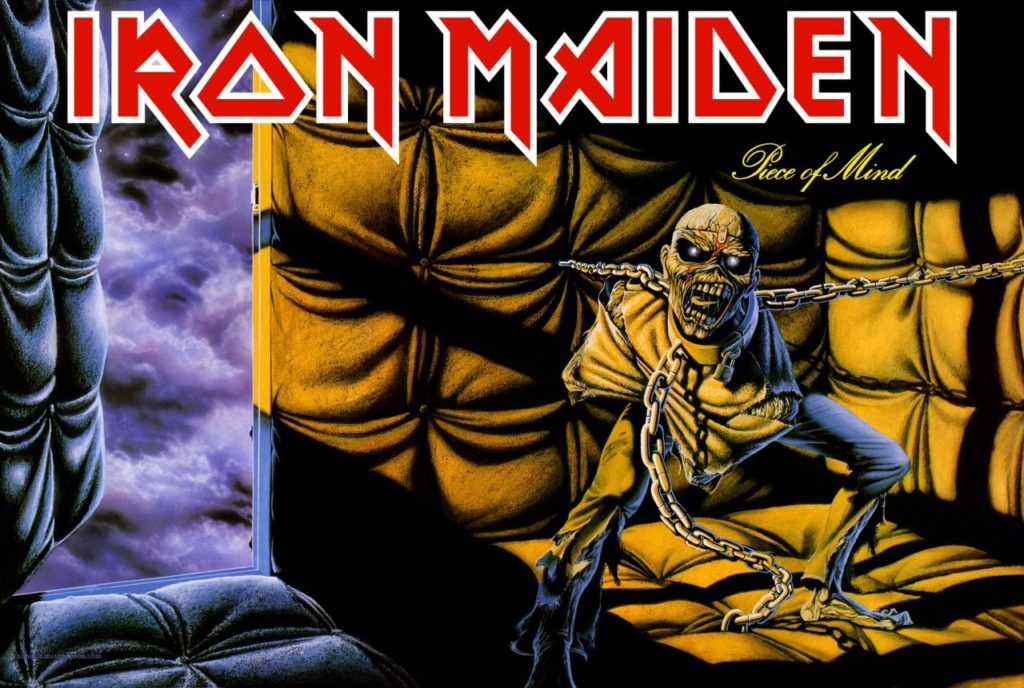
Iron Maiden, and in particular their bass-playing band leader (and frequently the main song writer) Steve Harris, often base their compositions on books, TV shows, history, and (to a lesser degree) other artists.
This was never more evident than on their fourth album Piece of Mind, released 16 May 1983, where just about every song boasted one such influence or another.
To Tame a Land was inspired by Frank Herbert’s 1965 science fiction novel Dune – and we’ll get back to that one in a minute. The frolicking Sun and Steel was based on the life of samurai Miyamoto Musashi, and titled after Yukio Mishima’s 1968 essay about him. Ramsey Campbell’s 1964 short story The Inhabitant of the Lake was the influence for Still Life, while The Trooper was inspired by Alfred, Lord Tennyson’s The Charge of the Light Brigade (1854).
Film influences are also present, such as Where Eagles Dare (based on Brian G. Hutton’s 1968 film, scripted by Alistair MacLean) and Quest for Fire (based on the 1981 film by Jean-Jacques Annaud). More exotic influences include Greek mythology for Flight of Icarus. On top of this, Revelations includes lines from G. K. Chesterton’s hymn O God of Earth and Altar while the remainder of the song is influenced by Aleister Crowley. This leaves Die With Your Boots On, which settles for being loosely based around the old western idiom about dying “on your post” – i.e. while living your life as usual.

To Tame a Land was meant to be entitled Dune after the novel, but there was one significant stumbling block to this: Dune author Frank Herbert. The band sought permission from Herbert’s agents, only to receive a tersely-worded refusal which amongst other things stated, “Frank Herbert doesn’t like rock bands, particularly heavy rock bands, and especially heavy rock bands like Iron Maiden.”
The band was struggling with satanic accusations in America at the time after the release of the album The Number of the Beast in 1982. The wording of the refusal, and especially a phrase like “especially rock bands like Iron Maiden,” certainly made people wonder what it was that Herbert had heard about them that would make them stand out so negatively.
Songwriter Steve Harris tried to tell Herbert what the band was really about, his thoughts behind the song, and just to convince him that the song would be a good promo for the book. Herbert had however made up his mind, and still refused.
In the end, the band was forced to change the name of the song, and Dune would forevermore become known as To Tame A Land. This also made them alter a few references in the lyrics. The song contains many seemingly senseless words, including “Fremen,” “Caladan,” “gom jabbar” and “Muad’Dib.” All of these were initially derived from the Dune novel and make sense in the context of the story. Singer Bruce Dickinson did end up ‘mispronouncing’ some of these words. References to Dune were however kept, as Herbert could not prevent them from having that word in the lyrics themselves, and it’s pretty clear what the song is about.
He is the King of all the land
In the Kingdom of the sands
Of a time tomorrow
He rules the sand worms and the Fremen
In the land amongst the stars
Of an age tomorrow
He is destined to be a King
He rules over everything
On the land called planet Dune
Bodywater is your life
And without in you would die
On the desert the planet Dune
We have never gotten too many details regarding the correspondance between Herbert and the band, but on stage in Stockholm on 5 June 1983, Dickinson had a rant which hinted at the unpleasantness of the situation. “The cu*t [Herbert] said that if we called this track ‘Dune’ he’d sue us and stop the album coming out, and all kinds of very unpleasant things” he revealed before they launched into it.
The quibbles with Herbert still did not diminish how proud Steve Harris was of the song. “This is the best song I’ve ever written,” he said in an interview when the album was released. “I was really pleased with Phantom of the Opera, but now I have to say that this is the best.”
The track certainly fits in well with the longer epics that the band would feature (usually one per album). It clocks in at 7:26 but could have been even longer, as at one point, Harris wanted to start the song with narration using a quote from Dune. This was made impossible by Herbert’s refusal. A shame, as several Maiden epics start in similar fashion, usually to great effect.
Iron Maiden always had more than a bit of a progressive flair in their approach to songwriting, arrangement and playing, as demonstrated by this song which goes through several movements. For a heavy metal band in 1983 their musical ambitions were light years ahead of their peers. Every arrangement in this song is non-standard, at times being downright complex. That really makes this a very intricate and interesting piece of music to listen to. It is definitely one of the most complex Iron Maiden songs in the first half of their career, with all of its insane song developments and complex interweaving of parts.
Iron Maiden would over time get a better understanding of how a song wasn’t necessarily less interesting just because it was a little more straightforward and simpler. To Tame A Land sits right smack in the middle of their most progressive years, and is a prime example of the band stretching as far as coming up with as many musical ideas as possible. This is very cool for the listener, but tough on the performers.
The band’s panache and ambition could yield glorious results, but would just as often come back to haunt them when the time came to play the material live. Vocalist Bruce Dickinson still laments how Quest For Fire, another song on the Piece of Mind album, has so many words in it that it’s impossible to sing live without dropping of suffocation.
The numerous movements in To Tame A Land led to related issues for that song. It was still played regularly on the Piece of Mind tour in 1983 – the band were after all incredibly proud of it. In the years to follow, however, it was more or less retired, and pulled out on very, very, very, very special occasions only. The song is very complex to pull off live, and for that reason it simply could not remain a mainstay in the setlists. This no doubt gave them food for thought as they reconsidered their approach to creating the more epic songs that was yet to come.
The song, and indeed the album it comes from, remains a grand showcase of their capabilities as songwriters and musicians. They were still relatively young and growing as musicians, but it is a representative indication of how far they were – and are – willing to go to get as much as possible out of their music.
For what it’s worth, the band left a final greeting to Frank Herbert on the back sleeve of the Somewhere In Time album (1986), where there is a “Herbert Ails” advertisement on a sign in the cityscape. This is a reference to the author of Dune. Who knows if he ever sued them over that one, or whether he is still contemplating it.

Facebook Comments